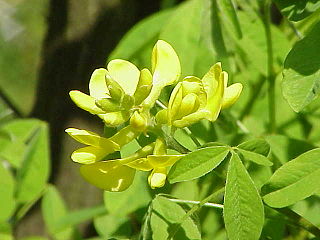
Petteria ramentacea, commonly known as Dalmatian laburnum, is a species of flowering plant in the family Fabaceae. It is a deciduous shrub native to the western Balkan Peninsula, including Greece, Albania, Bosnia and Herzegovina, and Montenegro. It grows up to 3 meters tall, and flowers in May. It grow in shrubland and scrub from 10 to 700 meters elevation, in both sub-Mediterranean and Mediterranean habitats. It belongs to the subfamily Faboideae. It is the only member of the genus Petteria.
Podocytisus caramanicus is a species of flowering plant in the family Fabaceae. It is a shrub native to the western Balkan Peninsula and southern Turkey. It is the only member of the genus Podocytisus. It belongs to the subfamily Faboideae.

Dipteryx is a genus containing a number of species of large trees and possibly shrubs. It belongs to the "papilionoid" subfamily – Faboideae – of the family Fabaceae. This genus is native to South and Central America and the Caribbean. Formerly, the related genus Taralea was included in Dipteryx.
Haplormosia is a monotypic genus of legumes in the family Fabaceae. Its only species is Haplormosia monophylla, commonly known as Liberian black gum, native to Cameroon, Ivory Coast, Liberia, Nigeria, and Sierra Leone. It is threatened by habitat loss.

Melolobium is a genus of flowering plants belonging to the legume family, Fabaceae. It includes 14 species of small shrubs or perennial herbs native to southern Africa, which are found in southern and eastern Namibia, southwestern Botswana, and most of South Africa.
Orphanodendron is a genus of legume in the legume family, Fabaceae. It includes two species of trees native to Colombia, which grow in tropical lowland forest. The genus is in subfamily Faboideae.

Pericopsis is a genus of flowering plants in the legume family, Fabaceae. It includes four species of trees and shrubs, three native to sub-Saharan Africa and one to Sri Lanka, Malesia, New Guinea, and the Caroline Islands. Typical habitats include tropical lowland forest and seasonally-dry woodland and wooded grassland.

Melhania is a genus of small shrubs or herbaceous plants. Traditionally included in the family Sterculiaceae, it is included in the expanded Malvaceae in the APG and most subsequent systematics. The genus is named for Mount Melhan in Yemen.

Adenolobus is a genus of African flowering plants in the legume family, Fabaceae. It belongs to the subfamily Cercidoideae.

Barklya is a genus of Australian trees in the legume family, Fabaceae. It belongs to the subfamily Cercidoideae. The sole species is Barklya syringifolia, commonly known as golden crown or golden glory. It grows in rainforest to 20 metres tall. Recorded from Queensland and New South Wales in rain forest. It is often used as an ornamental.
Baudouinia is a genus of flowering plants in the legume family, Fabaceae. It includes six species which are all endemic to Madagascar. It belongs to the subfamily Dialioideae.

Griffonia is a genus of central African flowering plants in the legume family, Fabaceae. It belongs to the subfamily Cercidoideae. Griffonia is known to have a high concentration of 5-HTP in its seeds.

Bolusanthus speciosus is a species of flowering plants in the family Fabaceae. It belongs to the subfamily Faboideae. It is the only member of the genus Bolusanthus.

Cadia is a genus of flowering plants in the family Fabaceae which belongs to the subfamily Faboideae. It includes 8 species native to northeastern Africa, the Arabian Peninsula, and Madagascar.

Hesperolaburnum platycarpum is a species of flowering plants in the family Fabaceae. It belongs to the subfamily Faboideae. It is the only member of the genus Hesperolaburnum. It is a tree or shrub endemic to Morocco.

Hypocalyptus is a genus of flowering plants in the family Fabaceae. It includes three species of shrubs, subshrubs or small trees native to the Cape region of South Africa. Typical habitats include Mediterranean-climate shrubland (fynbos) at forest margins, in rocky and sandy areas, and along streams, often at high elevations.
Rhynchotropis is a genus of flowering plants in the legume family, Fabaceae. It includes two species of herbs native to the Democratic Republic of the Congo, Angola, and Zambia. Typical habitats include seasonally-dry tropical woodland and wooded grassland in the northern Zambezian region, often in seasonally-damp or open sandy and rocky areas. It belongs to tribe Indigofereae of subfamily Faboideae.

Vatairea is a genus of flowering plants in the legume family, Fabaceae. It includes eight species of tall trees native to the tropical Americas, ranging from southern Mexico to Bolivia and southern Brazil. Seven species are native to northern South America, with the center of diversity in Amazonia. Vatairea lundellii ranges from southern Mexico to Panama. Most species grow in tropical rain forest, often in the inudated forests known as igapó and varzea, where they are emergent trees, growing above the forest canopy. V. macrocarpa grows in seasonally-dry forest, cerrado, and caatinga.

Pterodon is a genus of flowering plants in the legume family, Fabaceae. It includes four species of trees native to Brazil and Bolivia. Typical habitats include seasonally-dry tropical forest, woodland (cerrado), and thorn shrubland (caatinga), often on rocky outcrops. It belongs to the subfamily Faboideae.

Cytisus nigricans, the black broom, is a species of flowering plant in the subfamily Faboideae of the family Fabaceae. Growing 3–5 ft (0.91–1.52 m) tall, it is a slender deciduous shrub with erect branches. Masses of brilliant yellow, slightly fragrant pea-like flowers appear in long racemes on the current year's growth in summer and early autumn.















